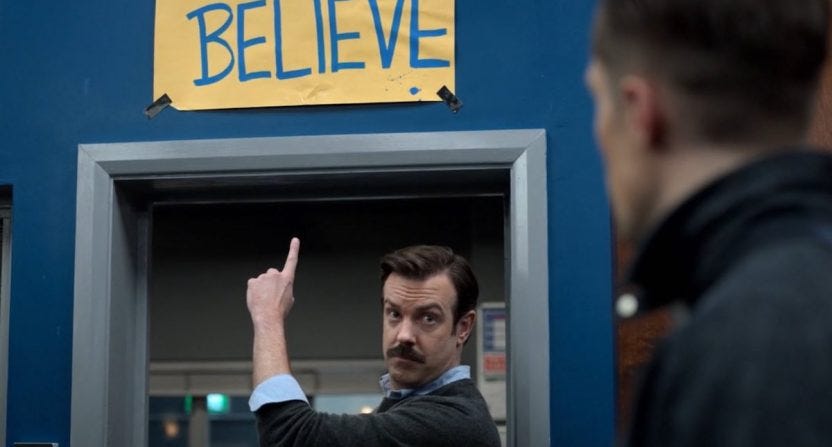SUNDAY MUSINGS are short reflections from the Cottage about faith, hope, and love — because we all need encouragement along the way.
I started watching Ted Lasso recently. The award-winning series (streaming on AppleTV) is about a cheerful Kansas football coach who winds up in London coaching AFC Richmond, a flailing English soccer team.
Ted Lasso has a dedicated fan base, a group that loves asking newcomers: Who is your favorite character? I love Ted (of course!), Rebecca (the team owner), and Roy Kent (the aging team star). But it is a quiet character, a background figure appearing in every show with only a single line, that I find utterly compelling: the BELIEVE sign.
I’ve not yet finished watching the available shows (so please no spoilers in the comments!). But that BELIEVE sign begs a question: What does it really mean to believe? Through all the team’s tensions, surprising victories, and painful losses, the sign hangs in the locker room, ambiguously omnipresent:
Is “believe” merely a kind of happy-talk self-help mantra, a sweet midwestern optimism oddly out-of-place in a more cynical world? BELIEVE and your dreams of winning and fame will come true.
Or, is “believe” something else? A disposition that is truthful, a practice that is transformative, a challenge to embrace, a struggle to endure? BELIEVE how? BELIEVE what? BELIEVE who? There are no predetermined answers, and finding a way to belief is messy.
From one perspective “BELIEVE” seems to taunt. If you believe hard enough, you will be rewarded. But, from the other, there is less clarity and maybe even unexpected sadness; BELIEVE seems to draw us toward our doubts and fears.
Almost twenty years ago, a few sentences in The Heart of Christianity by Marcus Borg revolutionized how I understood “believe”:
Prior to the seventeenth century, the word “believe” did not mean believing in the truth of statements or propositions, whether problematic or not. Grammatically, the object of believing was not statements, but a person. Moreover, the contexts in which it is used in premodern English make it clear that it meant: to hold dear; to prize; to give one’s loyalty to; to give one’s self to; to commit oneself. It meant. . . faithfulness, allegiance, loyalty, commitment, and trust.
Most simply, “to believe” meant “to love.” Indeed, the English words “believe” and “belove” are related. What we believe is what we belove. Faith is about beloving God. . . To believe in God is to belove God. Faith is about beloving God and all that God beloves. . . Faith is the way of the heart.
If the BELIEVE sign means “I believe that AFC Richmond will win the championship. I believe that. I believe,” well, then you’d be in trouble. That’s a statement about the truth of something.
But I’ve come to think that the BELIEVE sign means “I believe AFC Richmond. I believe this team,” and the point becomes clearer: I trust this team, I trust these people, I give my allegiance to you all. The BELIEVE sign doesn’t conjure our desires for a specific answer or outcome. Instead, it creates the possibility to become different players, a different team, and a different kind of community — one called forth in what we belove.
Although I’ve not yet watched the all the episodes of Ted Lasso, the story seems to be exploring BELIEVE through questions of “faithfulness, allegiance, loyalty, commitment, and trust” through the relationships between the various characters — and how BELIEVE and BELOVE are of a piece. After all, how can we possibly believe without love?
INSPIRATION
Those who believe they believe in God, but without passion in the heart, without anguish of mind, without uncertainty, without doubt, and even at times without despair, believe only in the idea of God, and not in God himself.
―Madeleine L'Engle
Can we imagine a Christianity where the creed read:
I belove God the Father Almighty. . .
I belove Jesus Christ, his only son. . .
I belove the Holy Spirit. . . ?
What a difference that would make!
— Diana Butler Bass
Richard Rohr posted a reflection from my Freeing Jesus this week. If you missed it, please click HERE.
Please like, comment, and share!




I love this! In the Bible, where it says "whoever believes in Jesus will have eternal life " and in almost every other instance where the New Testament mentions believing in Jesus, the Greek word translated "believe" actually means to adhere to, to trust, and to rely on. It's my impression most people think believe just means an intellectual agreement that something is true. I used to think that, but it is so much more. Our English word, "believe," does not translate the original word well. I think the translations should include all these shades of meaning to really be accurate. The Amplified Bible does include them.
We must be careful with the word "love" – It is so romanticized in this time and culture. So, what does "loving God" mean? Being faithful to GOD has to do with trusting the “Way Life Is” - trusting the totality of the life that is given us on this planet, Earth. This includes all the aspects of experience which displease, disappoint, and frighten us. Americans often seek a life devoid of discomfort, unrest, and confusion. We often react to life’s difficulties with denial, distrust, and resentment. Yet, the faithful see what is happening and react with trust and a willingness to face Reality. They can direct attention to others and devise solutions to life’s challenges. They walk on life’s turbulent waters. Relevant group and solitary practice help us to maintain and strengthen “the courage to be.’